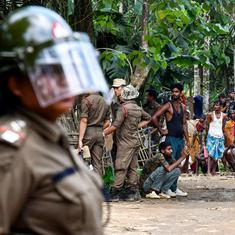A few days ago, a pop culture writer posted on X looking to speak with people who feel pressured into taking a stand on social media during times of conflict. The example the writer offered was the ongoing Israel-Palestine war. It was a bizarre journalistic request – reaching out to hyper-privileged people to comment on a war that would not affect them in any real way. I stared at the post for a few seconds and moved on but not before silently expressing my disapproval and wondering why any editor would green-signal this pitch.
Soon enough the post spread across X and many users (quite rightly) pointed out the ridiculousness of turning a humanitarian tragedy into a pop-culture piece. The writer, as many of them pointed out, was “content farming” a war of genocidal proportions. Needless to say, the writer deleted their post soon enough. I don’t think they will be pursuing the “story” any further.
The ridiculousness aside, I thought about how dystopian our lives have become. Even something as serious as a war requires taking sides and not just that, but explicitly voicing our opinions on social media. It doesn’t matter that none of us is in the war zone or doing any serious reporting on it, we must be seen having an opinion – even if that “opinion” means reposting views we agree with or sharing an Instagram story to make it clear to everyone with whom our sympathies align.
I’m not sure how any of this helps in the long run, but hasty posting and resharing on social media is an excellent way of spreading (more) disinformation – for instance, the many celebrities who shared photos of destruction in Gaza while they extended support to Israel. As for feeling pressured into taking a stand? I suppose every individual has a different way of responding to tragedy but to think that one could feel FOMO about a war is truly the most unreal byproduct of our neo-capitalistic world.
Performing resistance
This very 2020-era conundrum is at the heart of Rheea Mukherjee’s The Girl Who Kept Falling in Love. If you are reading this piece on Scroll, then it would not be audacious of me to assume that you are one of the more privileged people in our country and perhaps also someone who has attended some protest or the other at least once in their life. The two of us exist in this interesting cross-section of Indianness – we genuinely believe that we need to take to the streets to make our country less hostile than it is and we also often do this because we are expected to.
While some of our countrymen feel very real threats to their lives and livelihood, the least the rest of us can do is let the State know that we will not let these horrors slide and that we demand justice and dignity. It’s a good thing, a very good thing, but the proliferation of social media in every corner of the country has also turned resistance and protest into some sort of performance.
We are all too familiar with “protest aesthetics” – you have to dress a certain way, speak in a specific style, your placards should be snazzy and cool. It’s a way to fit into a particular crowd and live an aspirational life. Personal relationships have not been spared either – befriending or bedding people from marginalised minority communities can be social currency. Only if you do it right. The world is your protest ground and all of this can seem extremely appealing if you have the right surname and the right look, and disposable income to buy a one-way ticket out of India.
Kaya, the almost-40-year-old protagonist, is a girl who keeps falling in love. It starts with falling in love with a Black man in the US and finally marrying a Muslim man (who converts to Hinduism) in India. Between these two, there have been fleeting romances and a once-in-a-lifetime kind of love with a free-spirited, blue-haired woman, Anna.
Kaya’s friendship with Millie, an activist, is also not without motive. Though she’s truly in awe of her can-do spirit, Kaya also knows this association is good for her. But she acquires a Millie-pleasing attitude which is odd – and concerning – for a fully-grown adult. A friendship with a leftist Christian girl and a romantic relationship with A, a liberal Muslim man, is everything that Kaya, an America-raised child of divorcees, and a somewhat well-known writer, can hope for. Her social credentials are truly enviable to liberal, well-to-do Indians, but Kaya is a girl who simply cannot shake off her past.
Girl versus woman
She has a troubled past – she admits to falling deeply in love whenever she’s found the opportunity to but unfortunately for her, her partners and circumstances have not always shared this enthusiasm. Mixed with the subconscious desire for social acceptance, Kaya is a woman also afflicted with the maladies of being an older millennial. She has internalised the Internet lingo and everything that happens to her can be psychoanalysed by the most generic online phrases – “unavailability”, “self-awareness” etcetera. Apart from her breakup with Anna – which renders Kaya powerless in every way – it’s a life of smooth sailing.
The excessive self-pity and constant viewing of people through a class-caste-religion lens make Kaya so shallow that after a point, it becomes difficult to search for the “goodness” in her. So even though I had been reading about her love life since she was a teenager, I still found it impossible to see her as a complete person – what exactly are her goals other than the half-hearted social activist posturing?
When Millie is arrested for protesting a bit too much a bit too loudly, all Kaya manages to do is create a “Free Millie” page on Instagram. Millie becomes a legend of sorts with 24,000 followers. Her social media popularity ensures that she gets a VIP cell in jail. In Kaya’s words, the sexy, girl-boss aesthetic had been “maximised”. Millie is behind bars but life stops for no one.
Kaya and A jet off to the US where she meets her editor – who wants her to write a book about India’s “rapidly changing political landscape.” Kaya agrees and a $10,000 advance is agreed upon. She feels accomplished and in a rare moment of clarity, she acknowledges that “selling out has never been easier”. Life goes on, with or without Millie, and she was just being a “badass” looking out for herself.
Kaya’s selfishness and narrow-mindedness aside, it is truly horrifying to think that everything is indeed up for sale – the enemy only has to quote the right price. We are all preoccupied with our love lives and tend to think of it as a completely unique human experience that could only happen to us. That’s almost always not true. What especially infuriated me about Kaya was here she was, almost 40 and yet incapable of authenticity – be it as a lover, friend, or citizen.
She is not allowed redemption, which is all very well, but her wallowing and self-centred ways made it quite difficult to fully absorb myself into the story. Kaya is called a “girl” as opposed to a “woman”, perhaps to show she has been emotionally stagnant for the better part of her life – and I felt the same way about the book. The Girl Who Kept Falling in Love takes its chances to unpack contemporary Indians and make sense of a certain way of being and thinking. But a half-original storyline and an unlikeable protagonist do not deliver a punch, only a limp blow.

The Girl Who Kept Falling in Love, Rheea Mukherjee, Penguin India.










